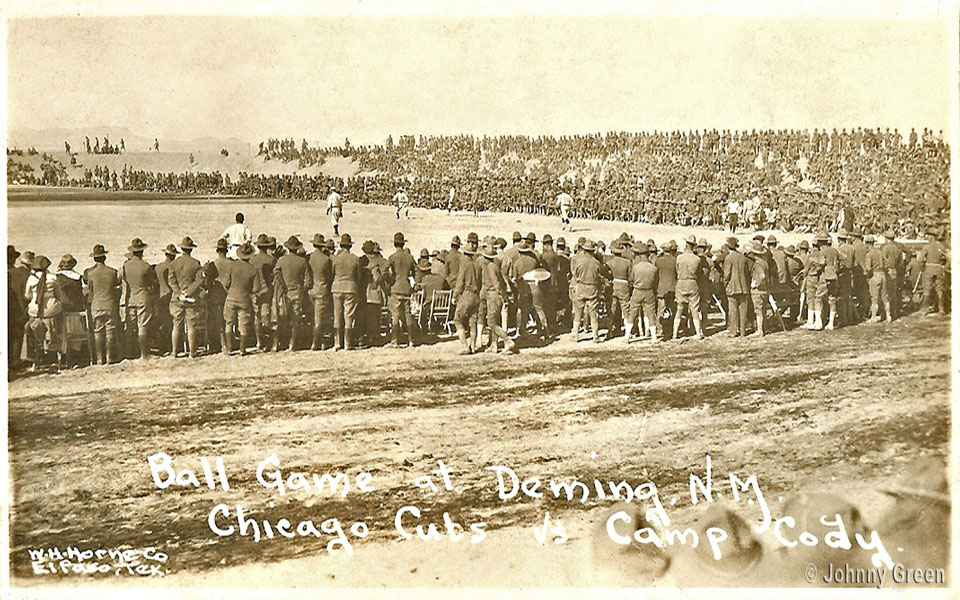Subscribe to my blog for automatic updates and as a Bonus get instant access to my two Free Special Reports: “Memorable World Series Moments,” and “Gary’s Handy Dandy World Series Reference Guide!”
Baseball and Military Service Photo Gallery
Click on any image below to start Photo Gallery:
Happy Memorial Day!
On this Memorial Day, 2016, here’s a little information about baseball and World War I. The featured photo shows the 1918 Cubs playing baseball against soldiers from Camp Cody in Dening, New Mexico.
With World I looming on the horizon, the major leagues went forward with their full schedule for 1917, while most minor leagues closed up shop. Only a handful of players had been drafted into the military and fewer enlisted. Those who continued to play took part in token military “drills” to show their support for the boys overseas, as seen in the photo above. It also was a way for ballplayers to avoid being seen as “slackers” – the common term at the time applied to those trying to avoid military service.
By 1918, the war caused the major leagues to shorten the regular season from 154 games to a 140 game schedule, ending on Labor Day, Monday, September 2. This was by the direction of Provost Marshall General Crowder, the director of the military draft. He originally decreed that by July 1, all draft-eligible men employed in “non-essential” occupations must apply for work directly related to the war—or gamble on being called into military service. Despite pleas for leniency from baseball’s owners, Secretary of War Newton D. Baker agreed with Crowder. A ballplayer’s career was deemed to be “non-essential.” The order was given: “Enlist to help stateside, or risk going to the front lines of Europe.”
Baseball was then given a reprieve of sorts. The “work or fight” deadline was delayed two months to September 1. And even then, the owners furiously lobbied for a deadline extension for World Series participants and the government reluctantly gave it to them. The World Series that year was played entirely within the month of September, the only time this has ever happened. Another first was the playing of “The Star Spangled Banner” before the first game of the World Series, a tradition that continues to this day before all games.
While many players performing stateside duties were accused of receiving preferential treatment, others in Europe clearly were not. Pete Alexander—the game’s best pitcher of the day—served in the front lines of France and suffered from shell shock, loss of hearing, and developed symptoms of epilepsy that later would drive him toward alcohol abuse. Ty Cobb and Christy Mathewson were part of a gas defense drill gone horribly wrong; Cobb escaped unharmed, but Mathewson inhaled a fair amount of poison gas. He gradually deteriorated and died of tuberculosis seven years later at the age of 45.
The following major-league players died as a result of their service in World War I:
Eddie Grant: killed in action in France
Tom Burr: died in a plane crash in France during a training accident
Bun Troy: killed in action in France
Ralph Sharman: drowned during training in Alabama
Larry Chappell: Spanish flu
Harry Glenn: Spanish flu
Newt Halliday: tuberculosis/pneumonia
Harry Chapman: died from wounds in Missouri
The following Negro League players died as a result of their service in the War:
Ted Kimbro: influenza
Norman Triplett: disease
Pearl Webster: influenza
Other notable players who missed considerable playing time due to military service in World War I include Hall of Famers Red Faber, and Harry Heilmann, Branch Rickey, and George Sisler. Also Gabby Street, Hank Gowdy, and Clarence Mitchell A number of players worked in wartime-related industries as War Plant Workers, particularly steel mills and shipyards, and missed playing time as a result (including Joe Jackson and Babe Ruth).
-Gary Livacari
Photo Credit: All from public domain.
Background Information: Excerpts edited from the “Baseball History in 1918” website; and the 1918 Baseball Wikipedia page.
-Gary Livacari
Subscribe to my blog for automatic updates and Free Bonus Reports: “Memorable World Series Moments” and “Gary’s Handy Dandy World Series Reference Guide.”

